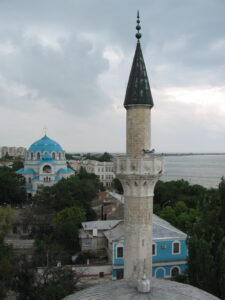
A modern conflict of the industrial era, the Crimean War also opened a new stage in world religion. Catholic France and Protestant Britain, two nations historically at odds over intricacies of faith, fought side by side as Allies. These Christian powers joined forces with an Islamic state. Armies of each major combatant, including Russia and the Ottoman Empire, reflected their diverse composition.[1] Karl Marx heralded the Crimean War as the dawn of a new post-religious age.[2]
Of course no such thing had happened. Instead, faith, in all its wartime complexities, persisted. After all, Christian denominations had come to violence in the competition for control over holy shrines in the Ottoman Empire less than a decade previous.[3] Tsar Nicholas listed religious freedoms in his announcement of war, while both the Ottoman and Russian Empires employed the language of holy war to motivate troops.[4] After the Crimean War had concluded, both empires engaged in a population exchange. Christians fled the Ottoman Empire, and Muslims from Russia took their places.
A few Americans stepped into this complex religious environment. Infused with religious devotion typical of the age, American missionaries had established a presence in the Ottoman and British Empires on the eve of war. They became swept up into the roar of violence. Though American missionaries did not see battle, their activities had indirect impacts on the battlefields.
Cyrus Hamlin is the most famous of these missionaries. Future president of Middlebury College, Hamlin operated a seminary in the Ottoman Empire at the outbreak of the Crimean War. To makes ends meet, his seminary baked bread. When war broke out, he became a chief supplier to the British Army Hospital in Istanbul. Across the continent, Samuel W. Richards, and his brother, Franklin D. Richards, had established a Mormon mission in England by 1853. Several of their acolytes volunteered in the British Army. These men proselytized in their regiments, sharing the Church of the Latter Day Saints with their fellow soldiers. They also fought at the Battles of Alma, and Balaklava. Several of the LDS band suffered casualties, and some fatal, at Inkerman.[5]
Notes
[1] British officers commanded Muslims from their own empire as well as a special regiment of Muslim bashibozuks. Algerian Muslims fought within the French army. Uhlan and Crimean Tatar Muslim regiments served in the Russian army. Christian regiments served the Ottoman Empire, most notably Cossacks from the Dobrudja, as well as Armenians who fought against Russia. See Ian Almond, Two Faiths, One Banner: When Muslims Marched with Christians across Europe’s Battlegrounds (Cambridge, MA: Harvard University Press, 2009).
[2] Karl Marx, “The Decay of Religious Authority,” New York Tribune, 24 Oct. 1855, in The Eastern Question: A Reprint of Letters written 1853-1856 dealing with the events of the Crimean War, ed. Eleanor Marx Aveling and Edward Aveling (London: Swan Sonnenschen & Co., 1897), 482-88.
[3] Orlando Figes, The Crimean War (New York: Metropolitan Books, 2014), 1-2. The controversy hit a nadir when more than forty Catholic and Orthodox priests and pilgrims died brawling over denomination held primacy over Christian holy shrines
[4] See Mara Kozelsky, Crimea in War and Transformation (Oxford and New York: Oxford University Press, 2019) for the Russian rhetoric; and Candan Badem, The Ottoman Crimean War (Leiden: Brill, 2010) for Ottoman context.
[5] Wilford Hill LeCheminant, “A Valiant Little Band,”: LDS Soldiers in the Crimean War, Ensign (1981) https://www.churchofjesuschrist.org/study/ensign/1981/01/a-valiant-little-band-lds-soldiers-in-the-crimean-war?lang=en